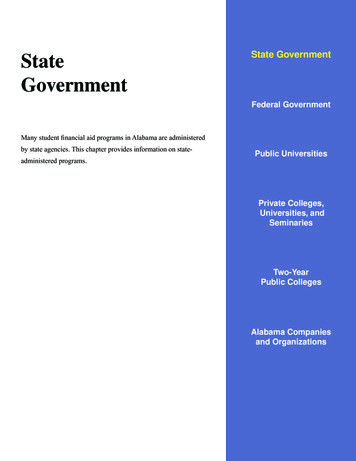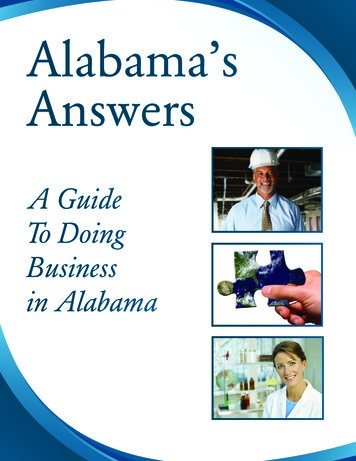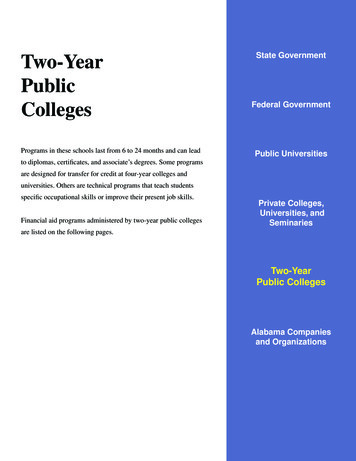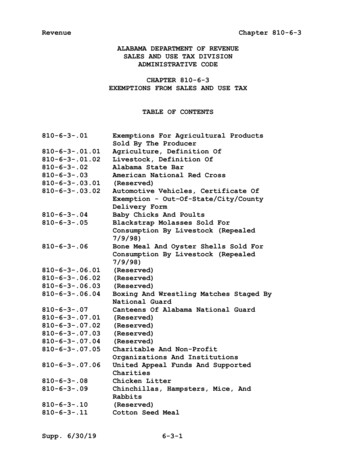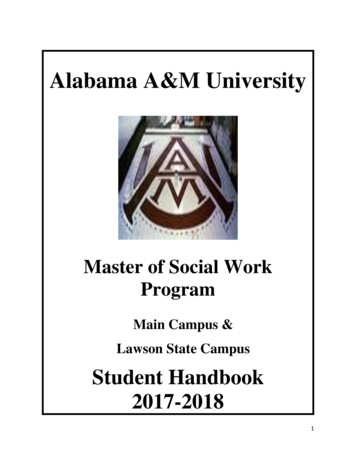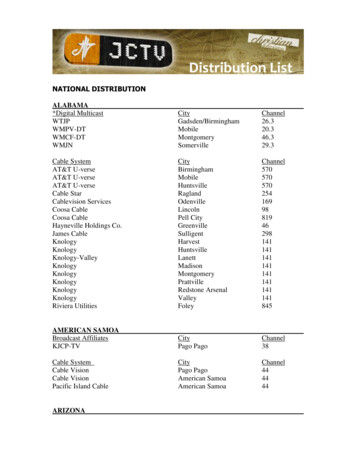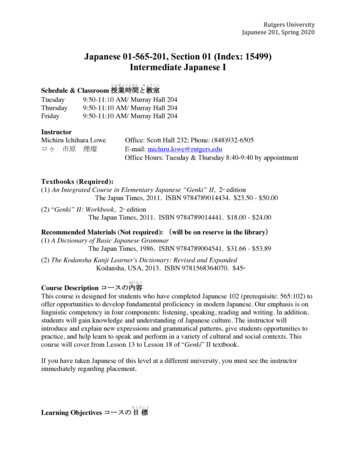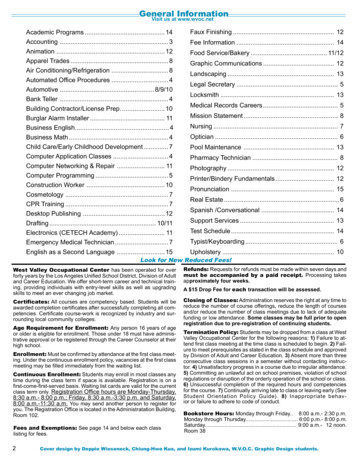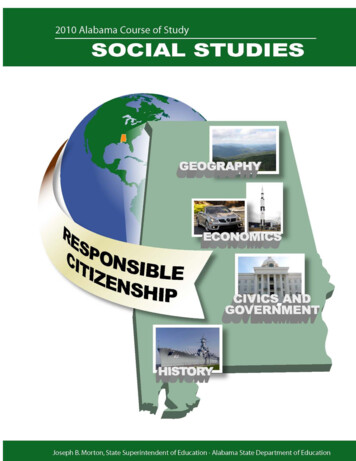
Transcription
201 OAlabama Course of StudySOCIAL STUDIESJoseph B. Morton, State Superintendent of Education Alabama State Department o f Education
For information regarding theAlabama Course of Study: Social Studiesand other curriculum materials,contact the Curriculum and Instruction Section,Alabama Department of Education,3345 Gordon Persons Building,50 North Ripley Street, Montgomery, Alabama 36104;or by mail to P.O. Box 302101, Montgomery, Alabama 36130-2101;or by telephone at (334) 242-8059.Joseph B. Morton, State Superintendent of EducationAlabama Department of EducationIt is the official policy of the Alabama Department of Education that no person in Alabama shall, on the grounds ofrace, color, disability, sex, religion, national origin, or age, be excluded from participation in, be denied the benefitsof, or be subjected to discrimination under any program, activity, or employment.
Alabama Course of StudySocial StudiesJoseph B. MortonState Superintendent of EducationALABAMA DEPARTMENT OF EDUCATION
STATE SUPERINTENDENTOF EDUCATION’S MESSAGEMEMBERSof theALABAMA STATE BOARDOF EDUCATIONDear Educator:Governor Bob RileyThe 2010 Alabama Course of Study: SocialStudies provides Alabama students and teacherswith a curriculum that contains content designedto promote competence in the areas ofeconomics, geography, history, and civics andgovernment. With an emphasis on responsiblecitizenship, these content areas serve as the fourorganizational strands for the Grades K-12social studies program. Content in thisdocument focuses on enabling students tobecome literate, analytical thinkers capable ofmaking informed decisions about the world andits people while also preparing them toparticipate responsibly in society at local, state,national, and international levels.The rigorous, challenging content standards inthis document offer a sound curricularframework designed to enable all students at allgrade levels to acquire the essential knowledgeand skills necessary to function in today’sinternational society. The Social Studies StateCourse of Study Committee and Task Force,composed of educators and business andcommunity leaders; the Alabama State Board ofEducation; and I believe the 2010 AlabamaCourse of Study: Social Studies provides asound program of instruction to be utilized byAlabama school systems as they design andimplement local social studies curricula.PresidentDistrict--IRandy McKinneyVice PresidentIIBetty PetersIIIStephanie W. BellIVDr. Ethel H. HallVice President EmeritaVVIVIIVIIIElla B. BellDavid F. Byers, Jr.Gary WarrenDr. Mary Jane CaylorPresident Pro TemState SuperintendentJoseph B. MortonSecretary and Executive OfficerJoseph B. MortonState Superintendent of Education2010 Alabama Course of Study: Social Studiesiv
Alabama Course of Study: Social StudiesTable of ContentsPREFACE . viACKNOWLEDGMENTS . viiGENERAL INTRODUCTION . 1CONCEPTUAL FRAMEWORK . 3POSITION STATEMENTS . 7DIRECTIONS FOR INTERPRETING THE MINIMUM REQUIRED CONTENT . 10MINIMUM REQUIRED CONTENTKINDERGARTEN-SECOND GRADE OVERVIEW . 12Kindergarten—Living and Working Together in Family and Community . 13First Grade—Living and Working Together in Family and Community and State . 15Second Grade—Living and Working Together in State and Nation. 18THIRD-FOURTH GRADE OVERVIEW . 21Third Grade—Geographic and Historical Studies: People, Places, and Regions . 22Fourth Grade—Alabama Studies . 25FIFTH-SIXTH GRADE OVERVIEW . 30Fifth Grade—United States Studies: Beginnings to the Industrial Revolution . 31Sixth Grade—United States Studies: The Industrial Revolution to the Present . 35SEVENTH-EIGHTH GRADE OVERVIEW. 41Seventh Grade—Geography . 42Seventh Grade—Civics . 48Eighth Grade—World History to 1500 . 51NINTH-TWELFTH GRADE OVERVIEW. 56Ninth Grade—World History: 1500 to the Present . 57Tenth Grade—United States History I: Beginnings to the Industrial Revolution . 62Eleventh Grade—United States History II: The Industrial Revolution to the Present . 67Twelfth Grade—United States Government . 73Twelfth Grade—Economics. 77APPENDIX A. High School Elective Courses Overview . 81Psychology . 82Sociology . 86Contemporary World Issues and Civic Engagement . 88Human Geography . 90APPENDIX B. QualityCore ACT Course Standards—U.S. History . 93APPENDIX C. Literacy Standards for Grades 6-12History/Social Studies, Science, and Technical Subjects . 94APPENDIX D. Alabama High School Graduation Requirements . 101APPENDIX E. Guidelines and Suggestions for Local Time Requirements and Homework. 102BIBLIOGRAPHY . 1042010 Alabama Course of Study: Social Studiesv
PREFACEThe 2010 Alabama Course of Study: Social Studies provides the framework for theGrades K-12 social studies program in Alabama’s public schools. Content standards and relatedcontent in this document are minimum and required (Code of Alabama, 1975, §16-35-4),fundamental and specific, but not exhaustive. In developing local curricula, school systems mayinclude additional content standards to reflect local philosophies and add implementation guidelines,resources, and activities; which, by design, are not contained in this document.The 2009-2010 Social Studies State Course of Study Committee and Task Force used informationfrom several professional documents as guidelines for the development of this course of study.These documents include the 1994 National Geographic Society’s Geography for Life: NationalGeography Standards, the 1994 Center for Civic Education’s National Standards for Civics andGovernment, the 1994 National Council for the Social Studies’ Expectations of Excellence:Curriculum Standards for Social Studies, the 1997 National Council on Economic Education’sVoluntary National Content Standards in Economics, the 1996 National Center for History in theSchools’ National Standards for History, the 2000 National Geographic Society’s A Path TowardWorld Literacy: A Standards-Based Guide to K-12 Geography, and the 2005 AmericanPsychological Association’s National Standards for High School Psychology Curricula.In addition, Committee and Task Force members attended state, regional, and national conferences;read articles in professional journals and other publications; reviewed similar curriculum documentsfrom other states; listened to and read statements from interested individuals and groups fromthroughout the state; used each member’s academic and experiential knowledge; and discussedissues among themselves and with colleagues. Using these sources, the Committee and Task Forcedeveloped what they believe to be the best possible social studies curriculum for Alabama’s K-12students.2010 Alabama Course of Study: Social Studiesvi
ACKNOWLEDGMENTSThis document was developed by the 2009-2010 Social Studies State Course of Study Committeeand Task Force composed of early childhood, intermediate school, middle school, high school, andcollege educators appointed by the Alabama State Board of Education and business and professionalpersons appointed by the Governor of the State of Alabama (Code of Alabama, 1975, §16-35-1).The Committee and Task Force began work in March 2009 and submitted the document to theAlabama State Board of Education for adoption at the May 2010 meeting.Social Studies State Course of StudyCommittee and Task Force MembersBarry R. Sadler, Ed.D., Superintendent, Eufaula City School System, 2009-2010 Social StudiesState Course of Study Committee ChairpersonSusan M. Anderson, Teacher, Rehobeth High School, Houston County School SystemJerry Blanks, Teacher (retired), Albertville City School SystemDiane L. Blocker, Teacher, Huntsville High School, Huntsville City School SystemGary Burton, President, Alabama Historical Association, Montgomery CountySusan Calhoun, Teacher, Fairhope High School, Baldwin County School SystemMatthew C. Carpenter, Teacher, McBride Elementary School, Muscle Shoals City School SystemJimmy Embry, Guntersville High School, Guntersville City School SystemWilliam Green, Teacher, Saks Middle School, Calhoun County School SystemJennifer Hill, Teacher, Charles Henderson Middle School, Troy City School SystemJanie Hillis, Teacher, Fayette Elementary School, Fayette County School SystemJacqueline Jackson, Program Specialist, Birmingham City School SystemBelinda Jones, Teacher, Walker Elementary School, Tuscaloosa County School SystemTirra Martinez, Teacher, Hillview Elementary School, Jefferson County School SystemTheresa McCormick, Ph.D., Associate Professor, Auburn UniversityChasity Miroff, Teacher, Brookwood Middle School, Tuscaloosa County School SystemLaura L. Mitchell, Mortgage Broker, Morgan CountyGloria Odutola, Education Specialist, Montgomery County School SystemKatharine Patton, Parent, Jefferson CountyPatricia Powell-McCullers, Teacher (retired), Monroe County School SystemHoward O. Robinson II, Archivist and Associate Professor, Alabama State University2010 Alabama Course of Study: Social Studiesvii
Carmen Smith, Teacher, Union Springs Elementary School, Bullock County School SystemJodi South, Teacher, Lincoln Elementary School, Talladega County School SystemRichard Stamper, Teacher, Spain Park High School, Hoover City School SystemYolanda Stevens, Teacher, Jefferson Davis High School, Montgomery County School SystemWilliam Strong, Ph.D., Professor, University of North AlabamaMisty Trussell, Teacher, Redland Elementary School, Elmore County School SystemVivian Turner, Teacher, Robert C. Hatch High School, Perry County School SystemAngela J. Williams, Teacher, Saraland Elementary School, Saraland City School SystemCarolyn K. Williams, Assistant Principal, Lee High School, Huntsville City School SystemAppreciation is extended also to Dorothy Autrey, Ph.D., Alabama State University; Edwin C.Bridges, Ph.D., Alabama Department of Archives and History; Ruth Busby, Ed.D., TroyUniversity; Sarah Culver, Ph.D., The University of Alabama at Birmingham; D’LinellFinley, Ph.D., (retired), Auburn University at Montgomery; Glenn Sebastian, D.A., University ofSouth Alabama; Ronald Slaughter, Ph.D., Alabama A & M University; HoraceHuntley, Ph.D., The University of Alabama at Birmingham; and Gregory Waselkov, Ph.D.,University of South Alabama, who served as content reviewers of the document.State Department of Education personnel who managed the development process were:Thomas R. Bice, Ed.D., Deputy State Superintendent for Instructional Services;Cynthia C. Brown, Director, Curriculum and Instruction; andSarah F. Mason, Ed.D., Executive Secretary, State Courses of Study Committees, Curriculum andInstruction.State Department of Education program specialists who assisted the Committee and Task Force indeveloping the document were:Nettie Carson-Mullins, Social Studies Specialist, Curriculum and Instruction; andMartin Dukes, Social Studies Specialist, Curriculum and Instruction.State Department of Education process specialists who assisted the Committee and Task Force indeveloping the document were:Reneé Callen, Education Specialist, Assessment and Accountability;Susan B. Davis, Ed.D., Education Specialist, Curriculum and Instruction;Dorothy Dolasky, Ed.D., Education Specialist, Curriculum and Instruction;Martha Lockett, Education Specialist, Curriculum and Instruction;Steve McAliley, Education Specialist, Curriculum and Instruction;Ginger Montgomery, Education Specialist, Curriculum and Instruction;Phyllis Rase, Education Specialist, Curriculum and Instruction;Nancy Ray, Education Specialist, Curriculum and Instruction;Dan Roth, Education Specialist, Special Education Services;Christine Spear, Education Administrator, Curriculum and Instruction; andJanice Webb, Education Specialist, Curriculum and Instruction.2010 Alabama Course of Study: Social Studiesviii
Jacqueline L. Perdue, Administrative Assistant, Curriculum and Instruction, assisted with thepreparation of the document.Mary Nell Shaw, Graphic Arts Specialist, Communication Section, andCharles V. Creel, Graphic Arts Specialist, Communication Section, assisted in the development ofthe graphic design.Susan J. Blankenship, Education Specialist (retired), Alabama Department of Education, edited andproofread the document.The 2010 Alabama Course of Study: Social Studies was reviewed and updated in April 2013.2010 Alabama Course of Study: Social Studiesix
GENERAL INTRODUCTIONAlabama students find themselves living and learning in a world that is experiencing rapid changes,including a seemingly limitless abundance of knowledge unlike any humankind has everencountered. They are involved in and affected by local, national, and international events,including state constitutional and economic issues that directly affect both their education and theirstandard of living. In order to be successful citizens in today’s world, students need to beknowledgeable about the economic, geographic, historical, and political perspectives of the worldand its people. Since students are more directly involved in these issues and need information andstrategies to make informed decisions, the theme of the 2010 Alabama Course of Study: SocialStudies is responsible citizenship.Responsible citizens are informed and active citizens. They are aware of and participate in variouslevels of civic responsibility. Mastering standards included in this document provides all students inGrades K-12 with essential knowledge regarding economics, geography, history, and civics andgovernment. With this mastery, students develop an international perspective necessary for livingwisely in a world that possesses limited resources and that is characterized by cultural diversity.They learn to view the world and its people with understanding and concern and develop a sense ofresponsibility for the needs of all people, including a commitment to finding just and peacefulsolutions to national as well as international problems.In preparing the 2010 Alabama Course of Study: Social Studies, consideration was given to keyconcepts from a variety of sources, including six national standards documents. The course of studypresents the academic content, concepts, and skills of the strands of economics, geography, history,and civics and government that are essential to the study of democracy and to the development ofcompetent and responsible citizens. Using this document, teachers are able to design instruction forstudents in kindergarten through twelfth grade regarding the required content, which includes effortsto provide balance between United States history and world history and between and among themany disciplines of the social sciences and humanities.Content standards in this document describe the required knowledge and skills of economics,geography, history, and civics and government that students are expected to know and be able to doat a particular grade level. In kindergarten and the primary grades, specific content in each strand isclearly delineated and sequenced, serving as an important foundation for the new and increasinglyrigorous content at each successive grade level. All strands are included in every grade; however,one strand may be given more emphasis at one or more grade levels.Although important geographic skills and concepts are addressed in all grades, students in Grade 3and Grade 7 are involved in an intensive study of basic geography where they increase theirknowledge about the physical and spatial nature of the world and about relationships between peopleand their environments. The civics and government strand is addressed in each grade while inGrade 7 one-half year is devoted primarily to the civics strand and in Grade 12 the governmentstrand is addressed in the required one-semester course, United States Government. Civics andgovernment content is designed to enable students to become informed, responsible participants inpolitical life and to function as competent citizens committed to the fundamental values andprinciples of the constitutional democracy that established the republic of the United States ofAmerica. Likewise, history concepts and skills are included in each grade where students inGrades 5 and 6 as well as in Grades 10 and 11 concentrate on the study of the history of the UnitedStates, and students in Grades 8 and 9 focus on world history content. History content addresses the2010 Alabama Course of Study: Social Studies1
chronological development of the United States as a nation with a focus on historical development,an essential component in understanding how decisions made and actions taken in the past affect thepresent. While economics content is included for students in all grade levels, a one-semester coursewith a major emphasis on economics is required for students in Grade 12. The economics strandaddresses content that provides students opportunities to apply content knowledge, skills, andconcepts to their daily lives as competent consumers and producers as they learn to recognize therole of economics in local, state, national, and international policies.2010 Alabama Course of Study: Social Studies2
CONCEPTUAL FRAMEWORKThe conceptual framework graphic on page 6 provides an illustration or overview of the instructionalorganization and goal of the content of Alabama’s K-12 social studies program. The design and conceptsreflect both the theme and major components that provide unity and purpose in this document’s content.The goal of the program, responsible citizenship, is depicted on the banner encompassing the globe andspanning the state. Responsible citizens are informed and active, are cognizant of their roles in andconnections with the world, and are capable of making competent decisions that benefit the localcommunity, state, nation, and world. Depicted across the state are the four organizational strands of thesocial studies program—economics, geography, history, and civics and government. These strandsserve as the organizational components for the content standards, and each is addressed with increasingrigor at every grade level with an emphasis at selected grades as described in the General Introduction tothis document. Through careful local planning and effective classroom instruction, students are able toattain the program goal and accomplish the content standards within each strand at all grade levels.EconomicsRepresenting the economics strand on the conceptual framework graphic is the insert picturing Alabama’sautomobile and space industries. While economic content is embedded for students in all grade levels, asemester course with a major emphasis on economics is required for students in Grade 12. As studentsbegin to apply economics content in their daily lives as consumers and producers, they learn to recognizethe role of economics in local, state, national, and international policies. A sound program in economicseducation enables students to: Understand the free enterprise system, the American economy, and differing economic views,including the roles of entrepreneurs and the government;Explain the law of supply and demand in a market economy;Understand the international market system;Identify economic problems, including unemployment, inflation, and national debt;Understand concepts of money, personal finance, and opportunity costs;Understand roles of consumers and producers in the market economy of the United States;Apply financial literacy principles, including money management skills; andExplain costs and benefits of government intervention on the world economy.2010 Alabama Course of Study: Social Studies3
GeographyThe Appalachian Mountains region of the state is representative of the geography strand. Althoughimportant geographic skills and concepts are addressed in all grades, students in Grade 3 and Grade 7are involved in an intensive study of geography. Through the study of geographic skills and concepts,students are able to: Describe the world in spatial terms using maps and other geographic representations, tools, andtechnologies;Explain how human systems develop in response to physical environmental conditions andunderstand the relationship between physical geography and human history;Determine how regions are used to organize and analyze areas of Earth’s surface;Compare geographic patterns in the environment that result from processes of Earth’s physicalsystems; andExplain how cultural features, traits, and diffusion help define regions.HistoryThe history strand, depicted on the insert of the Battleship USS Alabama, provides a sense of Alabama’srole in historical events. History concepts and skills are included in each grade level; however, studentsin Grades 5, 6, 10, and 11 concentrate on a study of the history of the United States, while students inGrades 8 and 9 focus on world history content. Although students in Grade 4 focus on the study ofAlabama history, this content is embedded at other grade levels throughout the curriculum. Knowledgeof history is essential to understanding how decisions are made and how actions taken in the past affectthe present. Through history education, students become aware of their roles as responsible citizens.Historically informed students are able to: Construct a personal connection to historical events at home and abroad;Think critically and chronologically regarding major events occurring in the United States andthroughout the world;Critique a variety of historical documents;Engage in historical analysis and interpretation;Conduct historical research;Evaluate intricate connections among the past, present, and future; andEngage in decision making using historical knowledge and analysis.2010 Alabama Course of Study: Social Studies4
Civics and GovernmentThe state capitol building in Montgomery, as pictured on the conceptual framework graphic, symbolizesthe civics and government strand. Content standards in this strand focus on what governments are; whatthey do; and how citizens are involved at local, state, national, and international levels of government.While the civics and government strand is embedded in each grade level, students in Grade 7 concentrateon the area of civics during the instructional year, and Grade 12 students focus on United Statesgovernment. Students who display competent civics and government skills are able to: Define government and understand its historical foundations;Explain interrelationships of local, state, and federal governments;Understand basic values and principles of the American republic;Comprehend the relationship of the United States to the rest of the world; andIdentify rights and responsibilities of citizenship, including the practice of responsible citizenship.Implementation of the standards within each of the four strands provides an opportunity for all students toachieve essential social studies knowledge and skills and attain the goal of responsible citizenship. In thisway, students broaden their awareness of the growing connections among people and places around theworld. In addition, they realize that events in other countries and on other continents have a substantialeffect upon citizens of the United States and Alabama, and that events in Alabama and the United Stateshave an increasing effect upon others around the globe.2010 Alabama Course of Study: Social Studies5
2010 Alabama Course of Study: Social Studies6
POSITION STATEMENTSInstructional StrategiesResearch-based studies have determined that students have a variety of learning styles. Therefore, it isessential for teachers to use a differentiated approach to instruction in order to meet the needs of allstudents. Students learn and retain information more effectively when they are actively involved in thelearning process. Instruction should stimulate critical-thinking skills that enable students to analyze,critique, and evaluate data. Primary sources, the most current technology, literature, the arts, group andindividual projects, current events, and community service are all appropriate instructional strategies forthe social studies classroom. Effective teachers find ways to model inquiry-based learning concepts thathelp students gain independence as they develop strong study habits and accept responsibility for theirown learning.In an ever-changing world, it becomes even more critical for students to develop an understanding of howtoday’s world developed, the reasons from which conflict grows, and why and how differing peoplesrelate to each other and their world views. Facts, including historical dates, events, people, and places,are critical to an understanding of history. There is an implied understanding throughout this documentthat facts must be taught and mastered for students to have a foundation from which to develop historicalreasoning. Content standards are developed to require an increase in rigor of the curriculum beyond thelevel of rote memory; however, this does not indicate that classroom instruction should not requirestudents to learn key points.It is also important for students to memorize and recite as part of their class work. The shared coreknowledge of our common history is indispensable in a modern culture. Recitation of the Preamble to theConstitution, speeches from politicians and soldiers, poetry, or letters from a period in history build ineach student an appreciation of the cost of history to a people.Primary SourcesPrimary sources enrich the social studies program and enable students to visualize and empathize withpeople of other times and places. Teachers are encouraged to utilize modern technology to access thelimitless abundance of primary sources available to enhance the instructional needs of students. Sourcessuch as the United States Library of Congress provide a wealth of historical data that documents ournation’s history. In addition, museums, libraries, and cultural centers open doors to the arts, writings, andimaginings of people throughout the world. The richness of primary source materials expands the socialstudies class by broadening student learning and making history a living concept.2010 Alabama Course of Study: Social Studies7
Literature and the ArtsThe goal of a comprehensive education is the development of a literate student. Literature has asubstantial place, not just in the English language arts class, but also in the social studies class. Novels,stories, poems, biographies, and autobiographies open doors to varied times, places, and events andencourage students to become immersed in those stories. Good literature enables students to exploreissues or ideas in a safe environment as they learn to make judgments about the actions and emotions ofothers. Suggested readings for young persons, which include print as well as Web site sources, areavailable through The National Council for the Social Studies (NCSS).The arts, including music, dance, drama, and visual art, provide rich resources for gaining knowledge andunderstanding of our own as well as other cultures. Instruction in the social studies classroom shouldprovide opportunities for students to explore all aspects of the arts. At the lower grade levels, the arts arethe perfect vehicle for thematic-based teaching of social studies while students in the upper grades benefitfrom cross-curricular experiences. Teachers are encouraged to conduct research for connecting thehistorical period and place being studied to appropriate arts topics, including live arts experiences thatexpand student understanding of that moment in time. In addition, many resources for the social studiesclassroom are provided by arts education organizations throughout the state.Global ConnectionsThe NCSS deems it essential for students to develop an understanding of the realities of globalinterdependence among world societies and the Unit
The 2010 Alabama Course of Study: Social Studies provides Alabama students and teachers with a curriculum that contai

